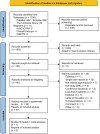Management of Cystoid Macular Edema in Retinitis Pigmentosa: A Systematic Review and Meta-Analysis
- PMID: 35652079
- PMCID: PMC9149278
- DOI: 10.3389/fmed.2022.895208
Management of Cystoid Macular Edema in Retinitis Pigmentosa: A Systematic Review and Meta-Analysis
Abstract
Background: To date, various treatments for cystoid macular edema (CME) in retinitis pigmentosa (RP) have been reported. We performed a systematic review and meta-analysis to evaluate the efficacy and safety of current treatments for RP-CME.
Methods: PubMed, Embase and the Cochrane library were searched from inception to August 2021. ClinicalTrials.gov, WHO ICTRP and ISRCTN were also searched for relevant studies. Only studies published in English were included. The RoB 2 tool was used to evaluate the risk of bias of randomized controlled trials (RCTs), and the MINORS scale was used to assess the methodological quality of non-RCTs. Review manager (Revman) was used to pool the data. The primary outcomes included the change of central macular thickness (CMT) and best-corrected visual acuity (BCVA) from baseline. The secondary outcomes included fluorescein angiography (FA) leakage, rebound of CME and adverse effects.
Results: Thirty-two studies were included in the current systematic review and 7 studies were used for meta-analysis. Treatments for RP-CME included oral and topical carbonic anhydrase inhibitors (CAIs), systematic and local steroids, anti-VEGF therapy, NSAIDS, grid LASER photocoagulation, subliminal micropulse LASER, vitrectomy, lutein supplement and oral minocycline. CAIs and local steroids were proved to be effective in reducing CMT. The effects of anti-VEGF reagents varied among studies. Regarding other treatments, only one study for each method fitted the inclusion criteria, so the evidence was very limited.
Conclusion: Topical CAIs, oral CAIs and local steroids are effective in treating RP-CME. However, due to the overall inferior design and small patient number of the included studies, the quality of evidence was poor. Systematic steroids, LASER, NSAIDS and vitrectomy may also be effective, nevertheless, considering the limited number of studies, no conclusion could be drawn regarding these treatments. More well-designed and conducted studies are needed in this field.
Systematic review registration: https://www.crd.york.ac.uk/prospero/display_record.php?ID=CRD42021273979, identifier CRD42021273979.
Keywords: carbonic anhydrase inhibitors; cystoid macular edema; meta-analysis; retinitis pigmentosa; steroids; systematic review.
Copyright © 2022 Chen, Liu and Peng.
Conflict of interest statement
The authors declare that the research was conducted in the absence of any commercial or financial relationships that could be construed as a potential conflict of interest.
Figures







Similar articles
-
Comparison of intravitreal anti-VEGF agents and oral carbonic anhydrase inhibitors in the treatment of cystoid macular edema secondary to retinitis pigmentosa.Front Pharmacol. 2024 Dec 10;15:1477889. doi: 10.3389/fphar.2024.1477889. eCollection 2024. Front Pharmacol. 2024. PMID: 39737070 Free PMC article.
-
Efficacy of carbonic anhydrase inhibitors in management of cystoid macular edema in retinitis pigmentosa: A meta-analysis.PLoS One. 2017 Oct 12;12(10):e0186180. doi: 10.1371/journal.pone.0186180. eCollection 2017. PLoS One. 2017. PMID: 29023491 Free PMC article.
-
Treatment of cystoid macular edema secondary to retinitis pigmentosa: a systematic review.Surv Ophthalmol. 2018 May-Jun;63(3):329-339. doi: 10.1016/j.survophthal.2017.09.009. Epub 2017 Oct 5. Surv Ophthalmol. 2018. PMID: 28987613
-
Management of cystoid macular edema secondary to retinitis pigmentosa via subliminal micropulse yellow laser.Lasers Med Sci. 2021 Mar;36(2):317-323. doi: 10.1007/s10103-020-03031-0. Epub 2020 May 4. Lasers Med Sci. 2021. PMID: 32363437 Clinical Trial.
-
Anti-vascular endothelial growth factor for macular oedema secondary to branch retinal vein occlusion.Cochrane Database Syst Rev. 2020 Jul 7;7(7):CD009510. doi: 10.1002/14651858.CD009510.pub3. Cochrane Database Syst Rev. 2020. PMID: 32633861 Free PMC article.
Cited by
-
The double-edged sword of inflammation in inherited retinal degenerations: Clinical and preclinical evidence for mechanistically and prognostically impactful but treatable complications.Front Cell Dev Biol. 2023 Apr 13;11:1177711. doi: 10.3389/fcell.2023.1177711. eCollection 2023. Front Cell Dev Biol. 2023. PMID: 37123408 Free PMC article.
-
Comparison of intravitreal anti-VEGF agents and oral carbonic anhydrase inhibitors in the treatment of cystoid macular edema secondary to retinitis pigmentosa.Front Pharmacol. 2024 Dec 10;15:1477889. doi: 10.3389/fphar.2024.1477889. eCollection 2024. Front Pharmacol. 2024. PMID: 39737070 Free PMC article.
-
Systemic Carbonic Anhydrase Inhibitors in Common Ophthalmic Diseases: A Scoping Review from A Clinical Standpoint.Curr Ophthalmol Rep. 2025;13(1):9. doi: 10.1007/s40135-025-00332-x. Epub 2025 Jul 8. Curr Ophthalmol Rep. 2025. PMID: 40642047 Free PMC article. Review.
-
Clearing the AIR: A PRPH2 mutation identified in the evaluation of presumed autoimmune retinopathy.Am J Ophthalmol Case Rep. 2025 Jan 18;37:102252. doi: 10.1016/j.ajoc.2025.102252. eCollection 2025 Mar. Am J Ophthalmol Case Rep. 2025. PMID: 39944181 Free PMC article.
-
Short-term efficacy and safety of nondamaging retinal laser therapy for retinitis pigmentosa-associated cystoid macular edema.Turk J Med Sci. 2025 Apr 17;55(3):652-657. doi: 10.55730/1300-0144.6012. eCollection 2025. Turk J Med Sci. 2025. PMID: 40686715 Free PMC article.
References
Publication types
LinkOut - more resources
Full Text Sources

